This Easy Focaccia bread recipe is easy to follow and yields a delicious, fluffy focaccia bread. You can easily change up the toppings to customize this easy focaccia bread recipe to make it match the rest of your meal and your flavor preferences. I have included directions for making Rosemary Focaccia Bread and also ways to change up the flavors.
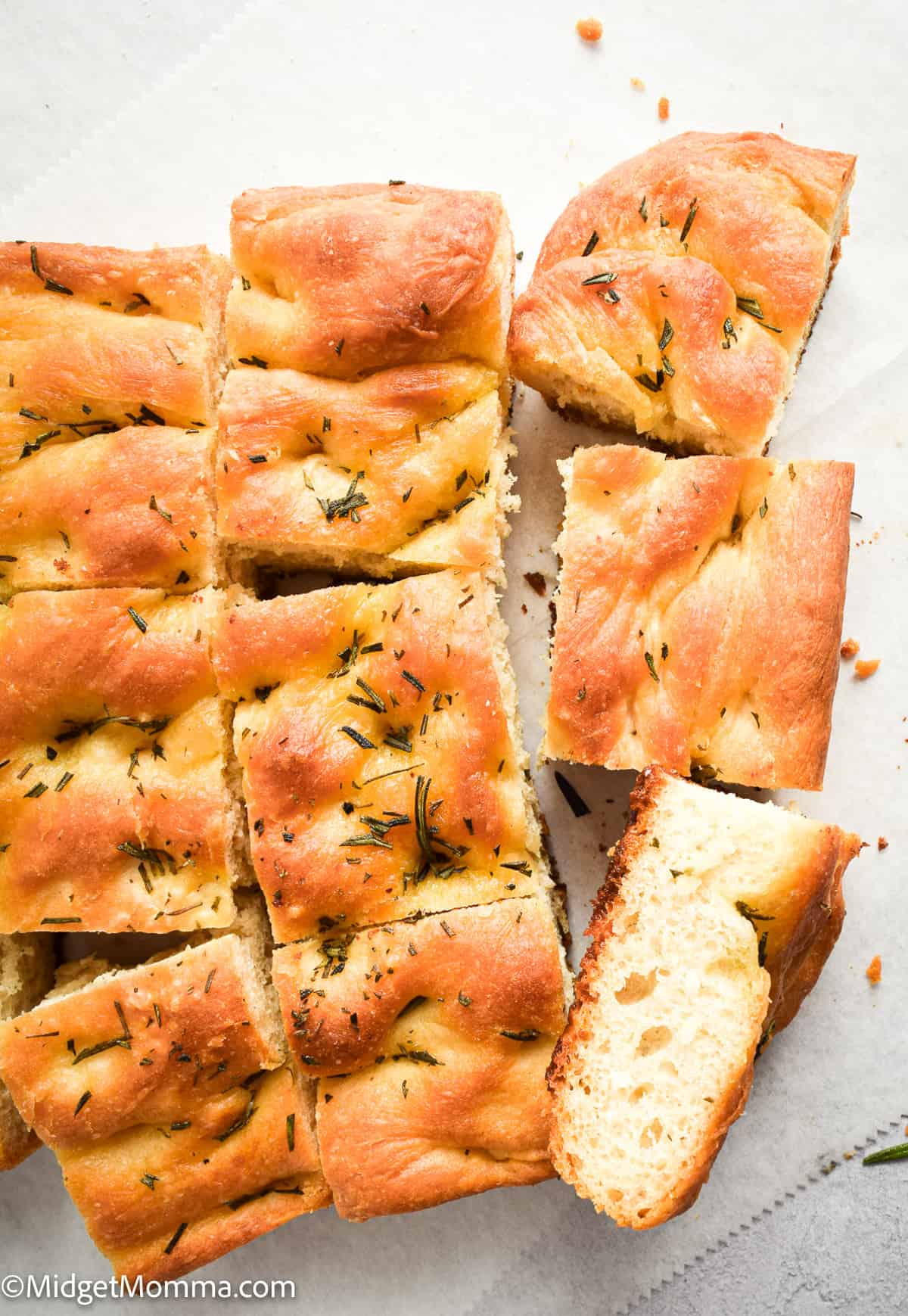
Easy Focaccia Bread Recipe
This Easy Focaccia Bread Recipe is made with love and the perfect blend of spices. It’s crispy on the outside and soft on the inside, making it the perfect bread for any meal. If you have never made homemade focaccia bread before you are in for a treat.
I know that making bread can sometimes be a scary thing if you have never done it before, but it is well worth trying your hand at making this delicious homemade bread. The easy Focaccia bread recipe is perfect for beginners learning how to make bread.
Now I am going to say in advance this is not a quick bread to make. You will make the dough and then let it rise 2 times, each for 1-2 hours depending on how fast the bread takes to rise. And then you will bake it in the oven. While making this bread does take a bit of time, it is not a difficult bread to make.
I have included all the things you need to know about making this bread, so your first time making Focaccia Bread will result with the perfect bread.
Bread Recipes
- Zucchini Bread Recipe
- Homemade white bread
- Blueberry Bread
- Panettone Bread
- Irish Soda Bread
- Ice Cream Bread
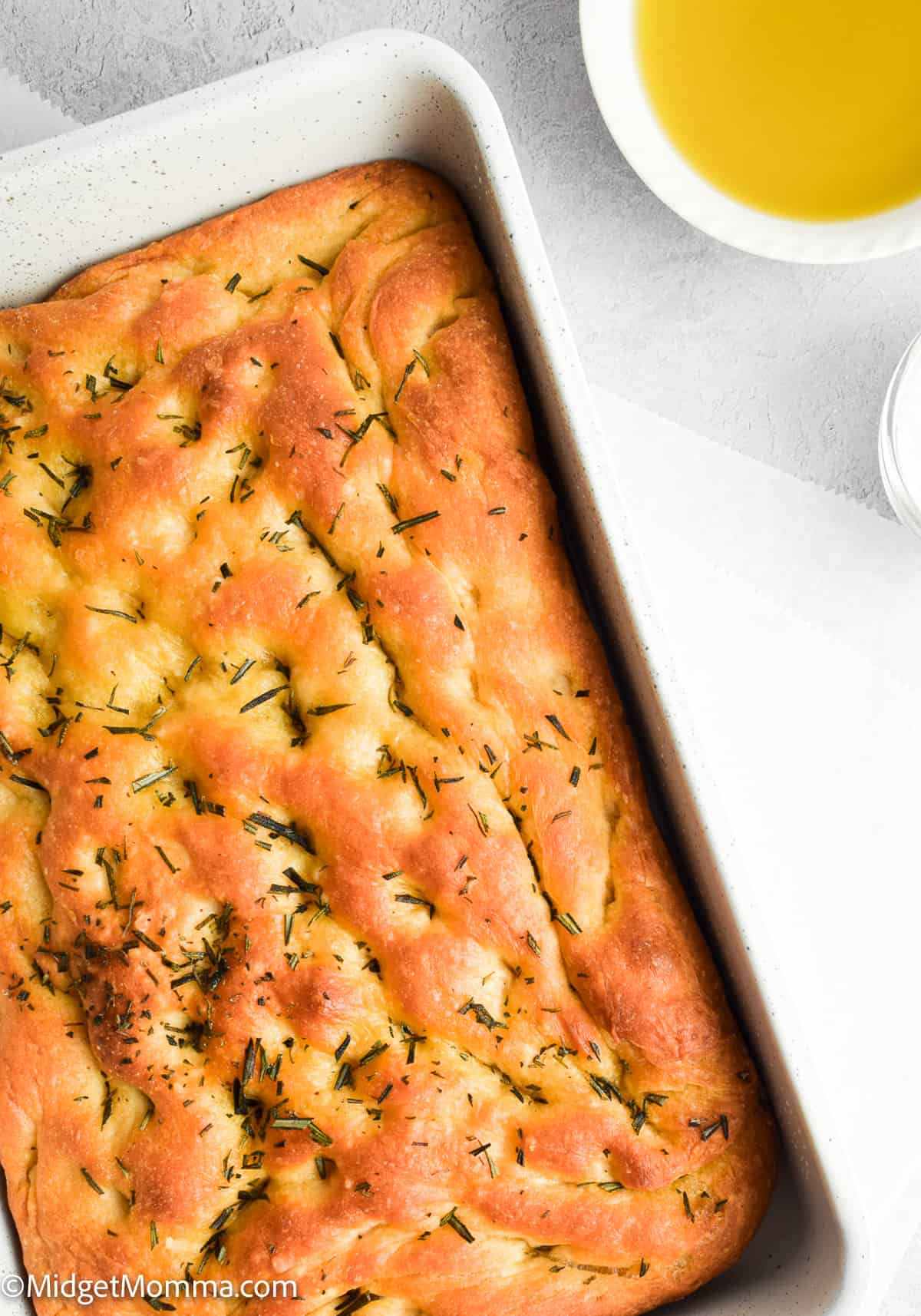
What is focaccia bread?
Rosemary focaccia bread is a type of Italian flatbread that is usually round or oval in shape. It is made with a dough that contains flour, yeast, water, salt, and olive oil. The dough is then topped with herbs and other toppings before being baked.
For this recipe, we are making a rosemary focaccia bread recipe, but I have also included instructions and options below for if you want to change up the flavors.
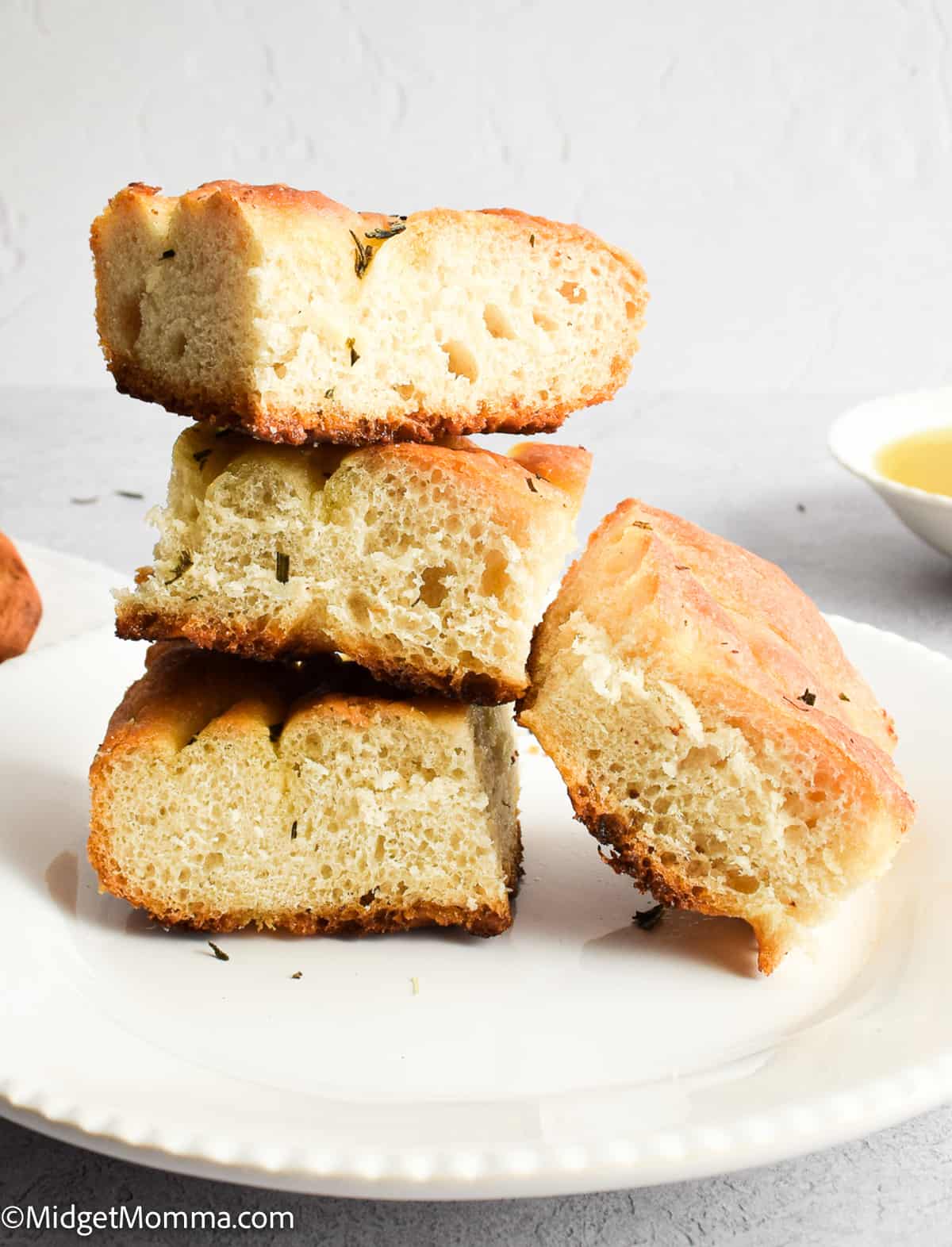
Tips & Must Know Information for Making Easy Focaccia Bread Recipe
Wetter dough than most breads. For focaccia, the dough is typically wetter compared to other bread types, so it’s important not to incorporate too much flour at the start of making the dough.
Sticky dough. If the dough sticks to the work surface when you are kneading it, it might require more flour. It is important to remember that at the beginning stages, the dough might be a little sticky, so refrain from adding more flour if you’ve only been kneading for a couple of minutes.
Might not fill your pan. It is important to note that when you are putting the bread into the baking dish and stretching it, it may not reach the edges of the pan. That is ok, since you are going to be letting it rest again.
Use a pan with enough space: A 12-inch cast-iron skillet or a 9×13″ pan works well for baking focaccia. Make sure the pan allows the dough to spread and rise evenly.
Baking temperature is Important. Preheat the oven thoroughly to ensure the right baking temperature. Focaccia generally requires a higher temperature to achieve that crispy golden crust.
Don’t skimp on dough rise time. You need the dough to rise to have the bread bake properly. The great things about making bread that needs time to rise is you can get other things done while you wait. Make sure to give it enough time to double in size during both the first and second rise.
Use a well-oiled bowl for rising: Coat the dough with oil and cover it with a damp cloth to prevent it from drying out during the rising process.
Use high-quality ingredients. Since focaccia has a simple flavor profile, the quality of the ingredients matters. Choose good quality olive oil, fresh rosemary, and high-grade flour for the best results.
Kneading is Important. Kneading the dough thoroughly helps to develop gluten, which gives the bread its characteristic chewy texture. Make sure to knead the dough until it’s smooth and elastic.
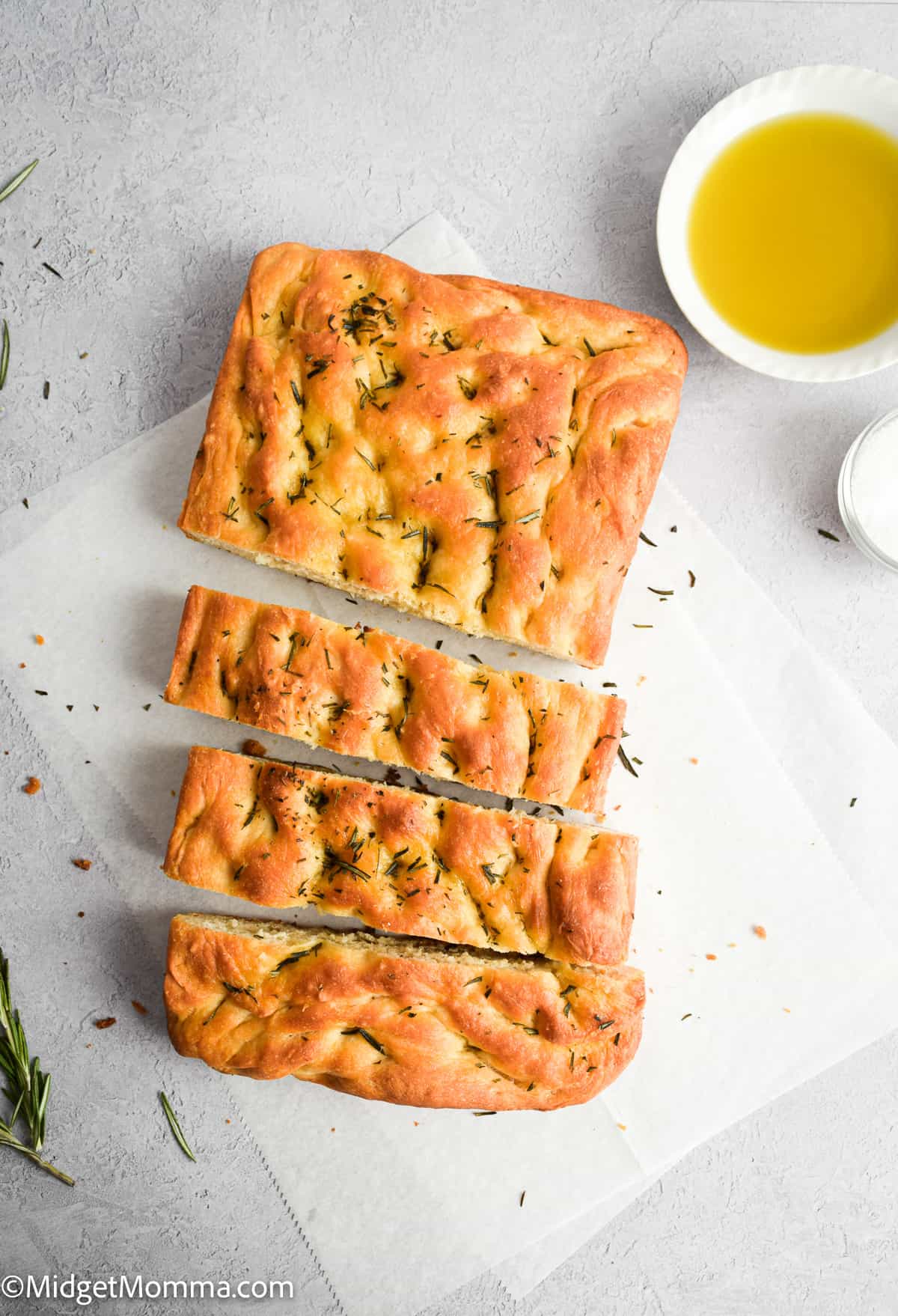
What Can I add to my Focaccia Bread?
While rosemary and sea salt are classic toppings, and the are the toppings on this rosemary focaccia bread recipe, you can experiment with other herbs, vegetables, or cheeses. Ensure not to overload the dough with toppings as it can weigh down the bread.
Switch the herbs around. While I adore using Rosemary for this bread, feel free to try Oregano, thyme, or basil for a different twist. Fresh herbs or dried herbs both work well.
Add some cheese. Prior to baking, consider sprinkling grated or shredded cheese on the surface. Parmesan, mozzarella, Gruyere, and goat cheese all make excellent choices.
Add some vegetables. Opt for tomatoes, caramelized onions, olives, mushrooms or roasted peppers as vegetable options. Ensure they are thinly sliced and of smaller sizes before placing them atop the bread.
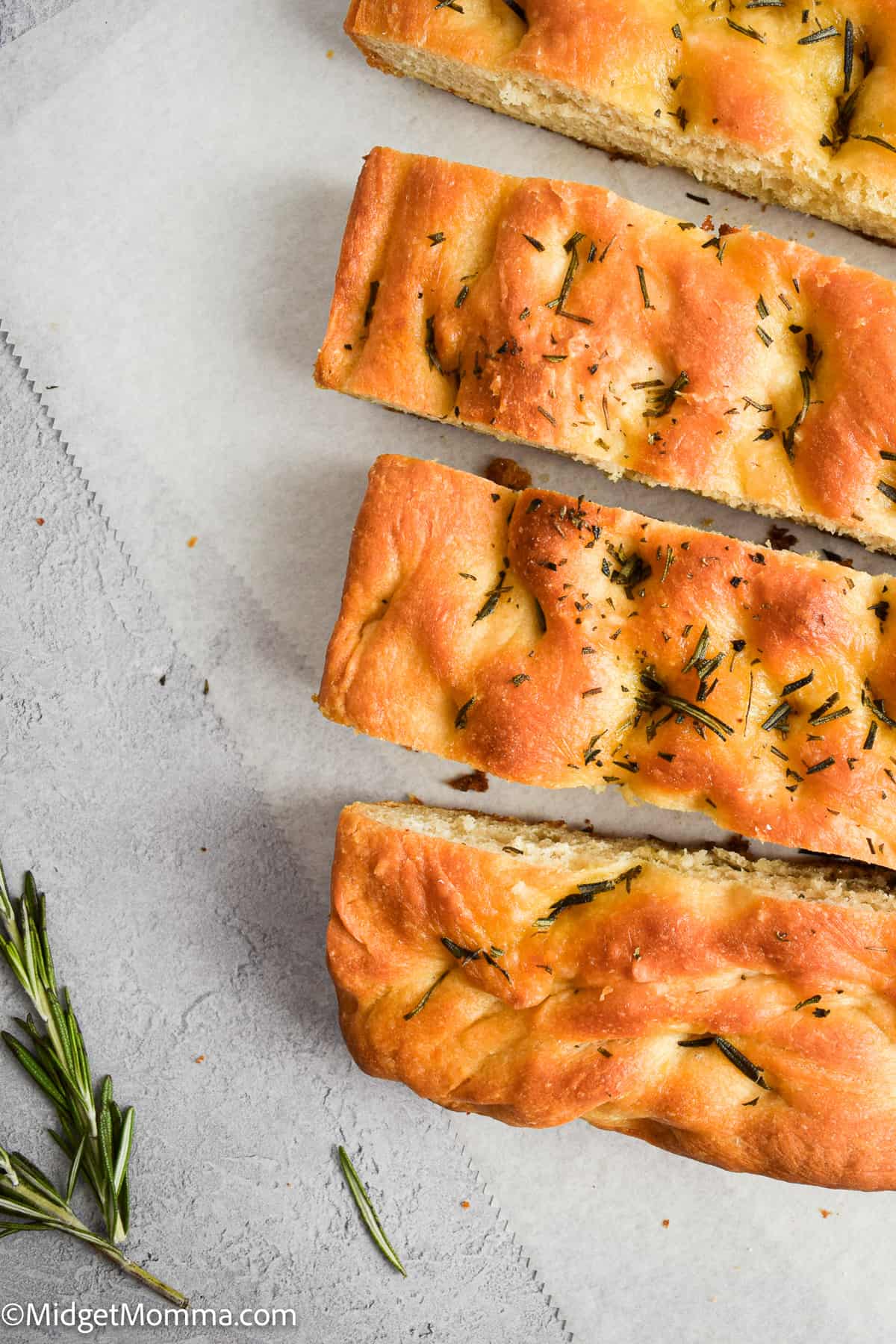
What are some good Flavor Combinations for Focaccia Bread?
Focaccia is a versatile bread that pairs well with a variety of toppings. While this exact recipe is for rosemary focaccia bread you can easily change up the flavors. Here are some delightful topping combinations to consider:
Roasted Red Peppers and Basil Pesto: Roasted red peppers, along with dollops of basil pesto, create a vibrant and flavorful topping that enhances the taste of the focaccia.
Cherry Tomatoes and Basil: Halved cherry tomatoes and fresh basil leaves create a vibrant and refreshing topping that complements the rich texture of focaccia.
Olives and Feta Cheese: Briny olives, such as Kalamata or green olives, combined with crumbled feta cheese, bring a Mediterranean twist to your focaccia.
Garlic and Parmesan: A classic flavor combination, minced garlic cloves, and grated Parmesan cheese create a savory and aromatic topping that adds a burst of flavor to your focaccia.
Pesto and Sun-Dried Tomatoes: Spread a layer of pesto on top of the dough and sprinkle it with chopped sun-dried tomatoes for a burst of Mediterranean flavors.
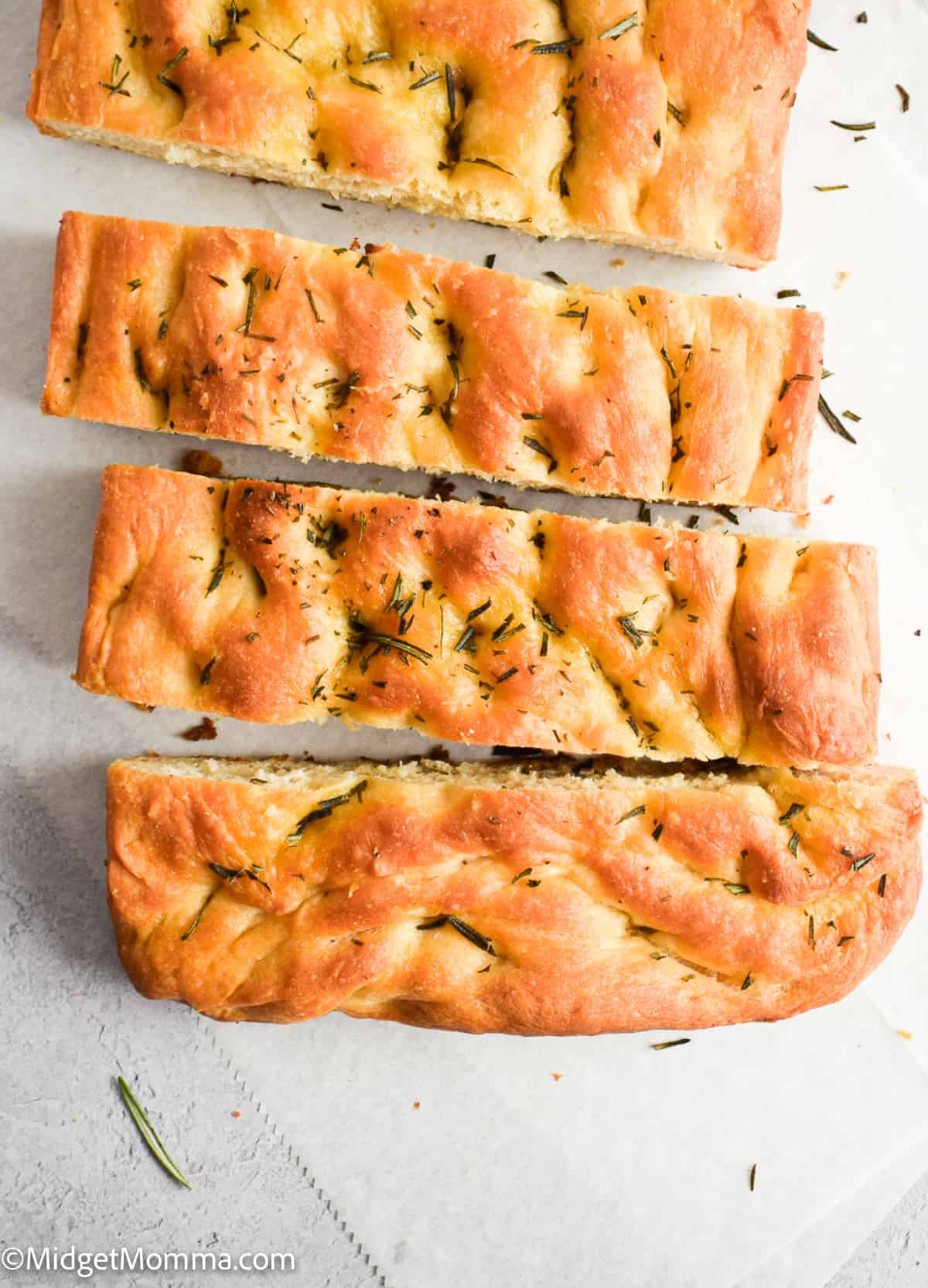
How to Cut Focaccia Bread
The most common way is to slice the bread horizontally, creating thin pieces of bread. This is ideal for sandwiches or dipping in soup. Another option is to cut the bread into squares or rectangles. This is perfect for appetizers or snacks. Simply top with your favorite toppings and enjoy.
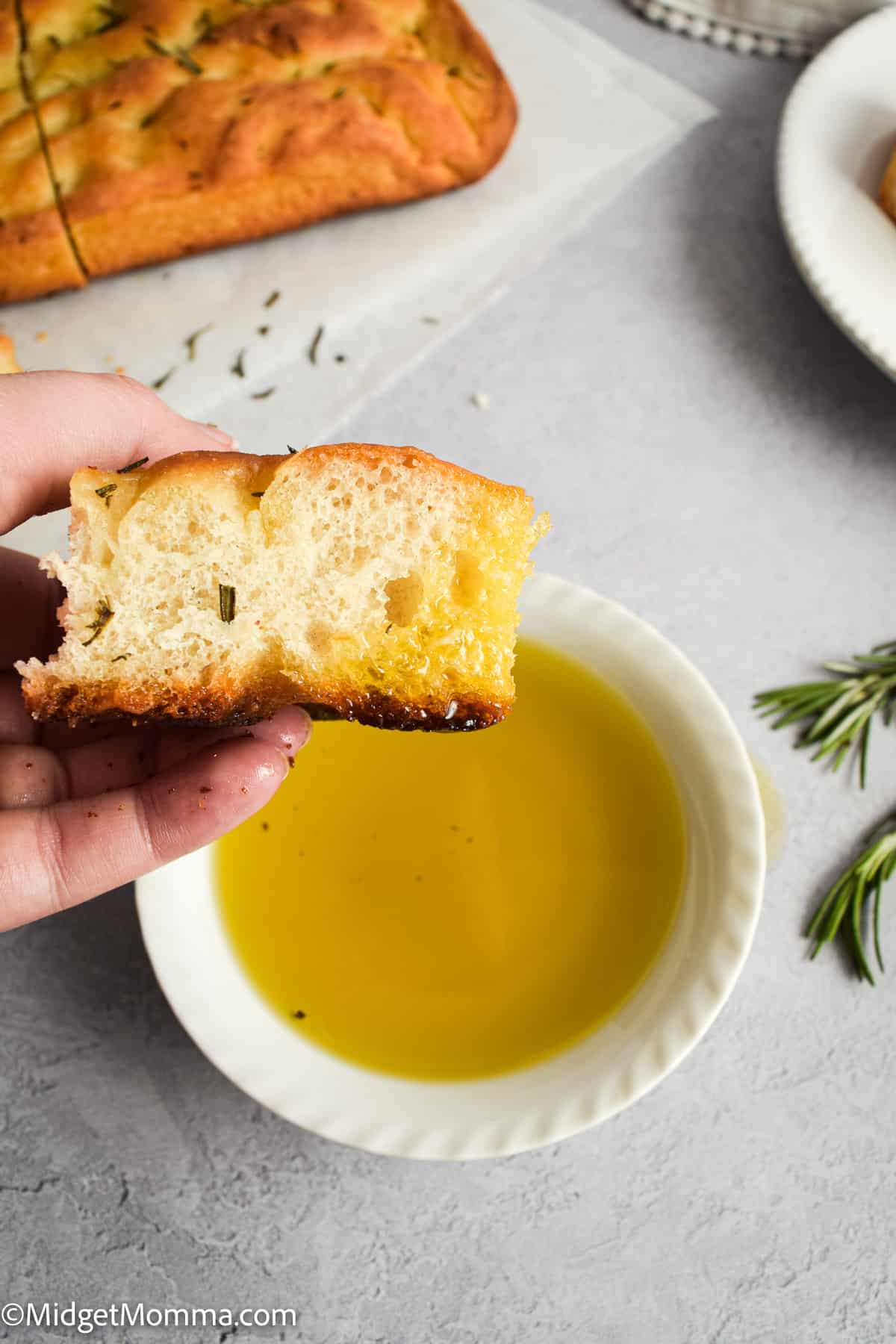
What does Focaccia Bread pair well with?
Focaccia pairs beautifully with a wide range of dishes and complements various flavors. Here are some serving suggestions:
Dips and Spreads: Serve focaccia alongside a selection of dips and spreads such as hummus, baba ganoush, tzatziki, or olive tapenade for a delightful appetizer or snack.
Soups and Stews: Focaccia makes a great accompaniment to soups and stews, especially those with rich and hearty flavors. It’s perfect for mopping up the delicious broth.
Salads: Pair focaccia with a fresh, crisp salad for a satisfying and balanced meal. It’s an excellent option to add a bit of substance to a light salad.
Cheese Platters: Focaccia works well with various cheeses. Serve it alongside a cheese platter featuring a selection of soft, semi-soft, and hard cheeses for a delightful and versatile combination.
Sandwiches: Use focaccia as a base for sandwiches, paninis, or bruschetta. Its robust texture and flavor make it an ideal bread for creating delicious and hearty sandwiches.
Charcuterie Boards: Incorporate focaccia into a charcuterie board along with cured meats, cheeses, fruits, nuts, and spreads for a delightful and visually appealing spread.
Dinner Entrees: Serve focaccia as a side dish with pasta, lasagna, or other Italian-inspired main courses. Its robust flavor and texture complement a wide range of Italian dishes.
Brunch Spreads: Include focaccia as part of a brunch spread alongside eggs, bacon, sausages, and fresh fruits.
Olive Oil and Balsamic Vinegar: Dip freshly baked focaccia in a mix of high-quality extra virgin olive oil and balsamic vinegar for a simple yet appetizer or snack.
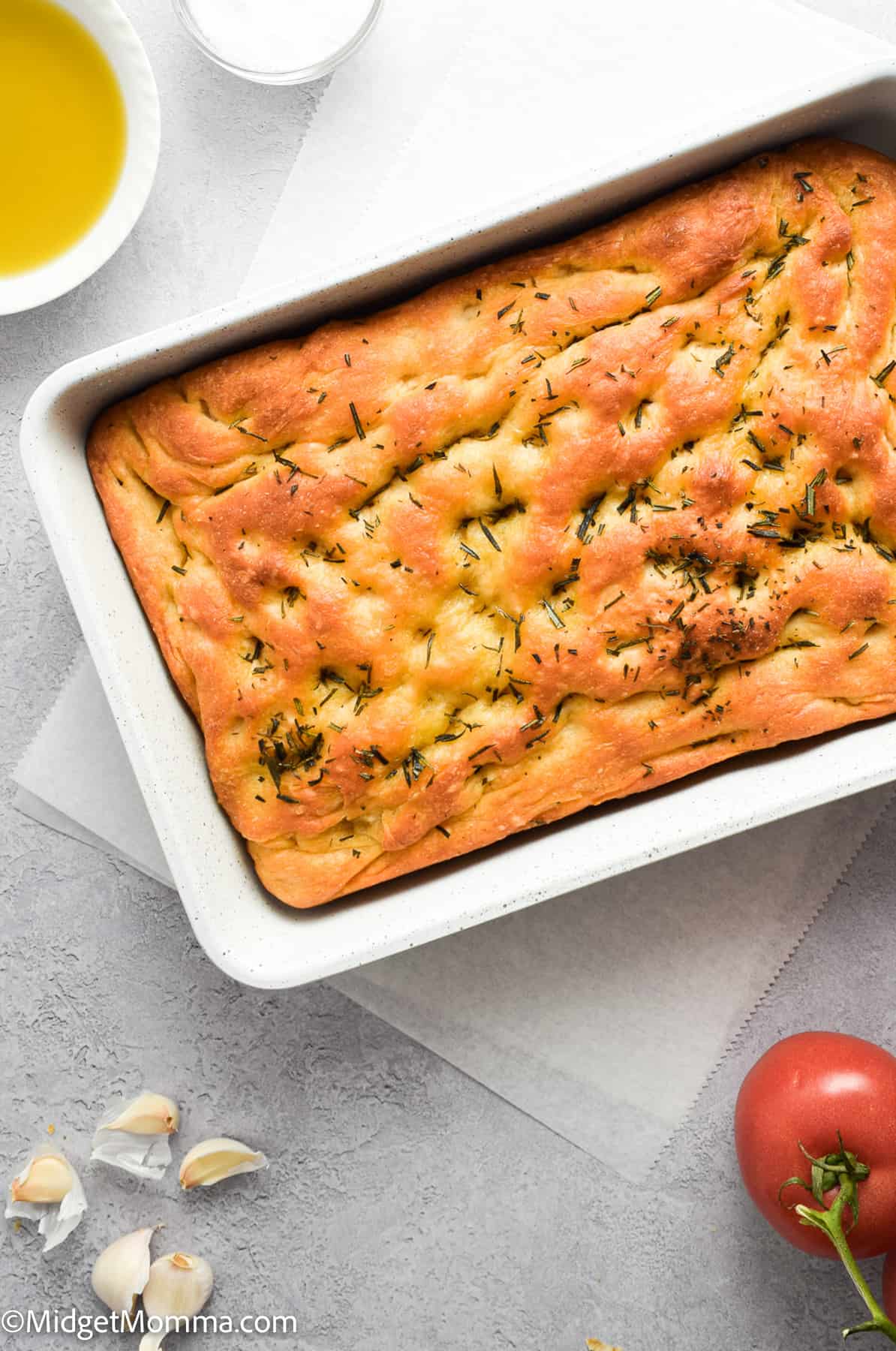
How to Store Focaccia Bread
Focaccia is best consumed fresh, preferably on the day it’s made. If you plan to consume it within a day or two, store it at room temperature in an airtight container or wrapped tightly in plastic wrap.
How to Reheat Focaccia Bread
When you’re ready to enjoy the leftover focaccia, you can reheat it in a preheated oven at 350°F for 5-10 minutes until it’s warmed through and the crust becomes crispy again. You can also toast it lightly in a toaster or toaster oven.
Can I Freeze Focaccia Bread?
Yes you can! If you have a large amount of leftover focaccia, you can freeze it for longer storage. To freeze, wrap the focaccia tightly in plastic wrap and place it in a freezer-safe bag or container. Make sure to label the package with the date. Frozen focaccia can typically be stored for up to 2-3 months.
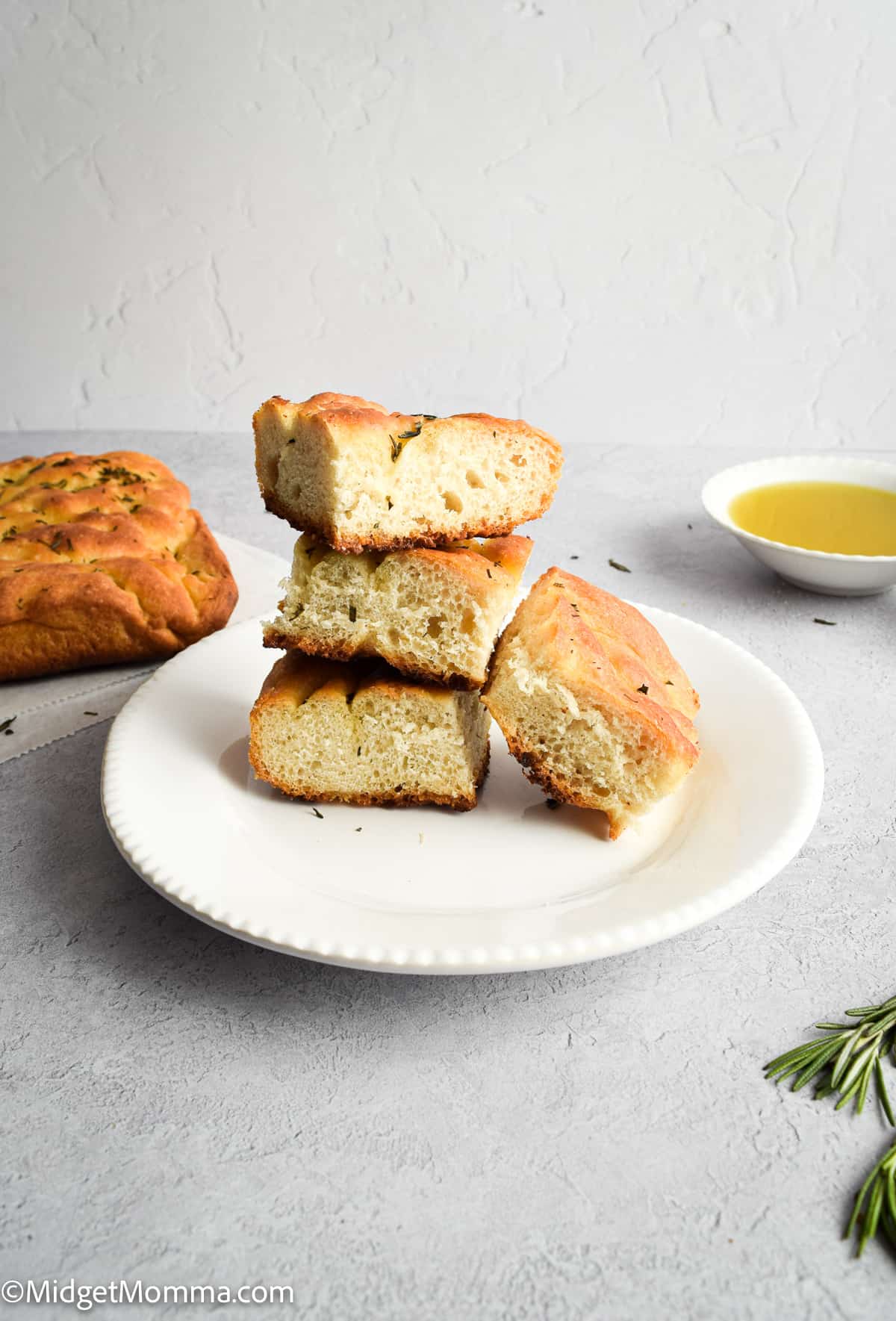
Recipe FAQ
Can I use a stand mixer to knead the dough?
You can use a mixer to mix the dough. You will want to use the dough hook.
Can I use active dry yeast?
Yes, you can use active dry yeast, but it will require a few more steps. I am mixing the instant yeast with the flour and salt, but if you are using active dry yeast, you will need to mix the yeast with 1.5 cups of warm water and allow it sit for 5 minutes first. Once it gets bubbles on the edges and starts to smell like yeast it is ready to use and you can go on to step 2.
Why Do You dimple the dough?
Dimpling the dough before baking helps to create pockets of air in the bread, resulting in a fluffy, light focaccia. It also allows the olive oil and herbs to seep into the bread, giving it even more flavor.
Why Didn’t My Dough Rise?
If your focaccia bread dough did not rise as expected, several factors might be responsible. Consider the following potential reasons:
Yeast issues: The yeast might have been inactive or expired. Check the expiration date and proof the yeast in warm water with a pinch of sugar before using it.
Temperature: Yeast is sensitive to temperature. If the environment is too cold, the yeast’s activity might slow down, leading to poor rising. Conversely, if it’s too hot, it can kill the yeast. Find a warm spot for the dough to rise, such as near a warm oven or on a countertop.
Over-proofing: Allowing the dough to rise for too long can cause the yeast to exhaust its food source, leading to poor rising during baking. Follow the recommended proofing time mentioned in the recipe.
Improper kneading: If the dough was not kneaded enough or was over-kneaded, it could affect gluten development, resulting in poor rising.
Ingredients: Low-quality flour or expired ingredients can affect the dough’s ability to rise properly. Use fresh, high-quality ingredients for the best results.
Why did the bottom of my bread burn?
If the bottom of your bread is burning during baking, there are a few common reasons why this might be happening:
Lack of preheating: Preheating the oven is essential to ensure even heat distribution. Failure to preheat the oven adequately can lead to uneven baking and burning, especially on the bottom.
Improper rack placement: Placing the bread too close to the bottom heating element can cause the bottom to brown or burn excessively. Always position the rack in the middle of the oven to ensure even heat distribution.
How to Make Focaccia Ahead of Time
This focaccia bread recipe is perfect for busy schedules. The dough can be made in advance and refrigerated until ready to use. Simply bake the focaccia bread and enjoy!
In order to make it ahead, follow the recipe through proofing. Then, place the dough in a greased bowl, cover with plastic wrap, and refrigerate for up to 24 hours.
When you’re ready to bake, remove the dough from the refrigerator and let it come to room temperature. Then, proceed with the recipe as directed.
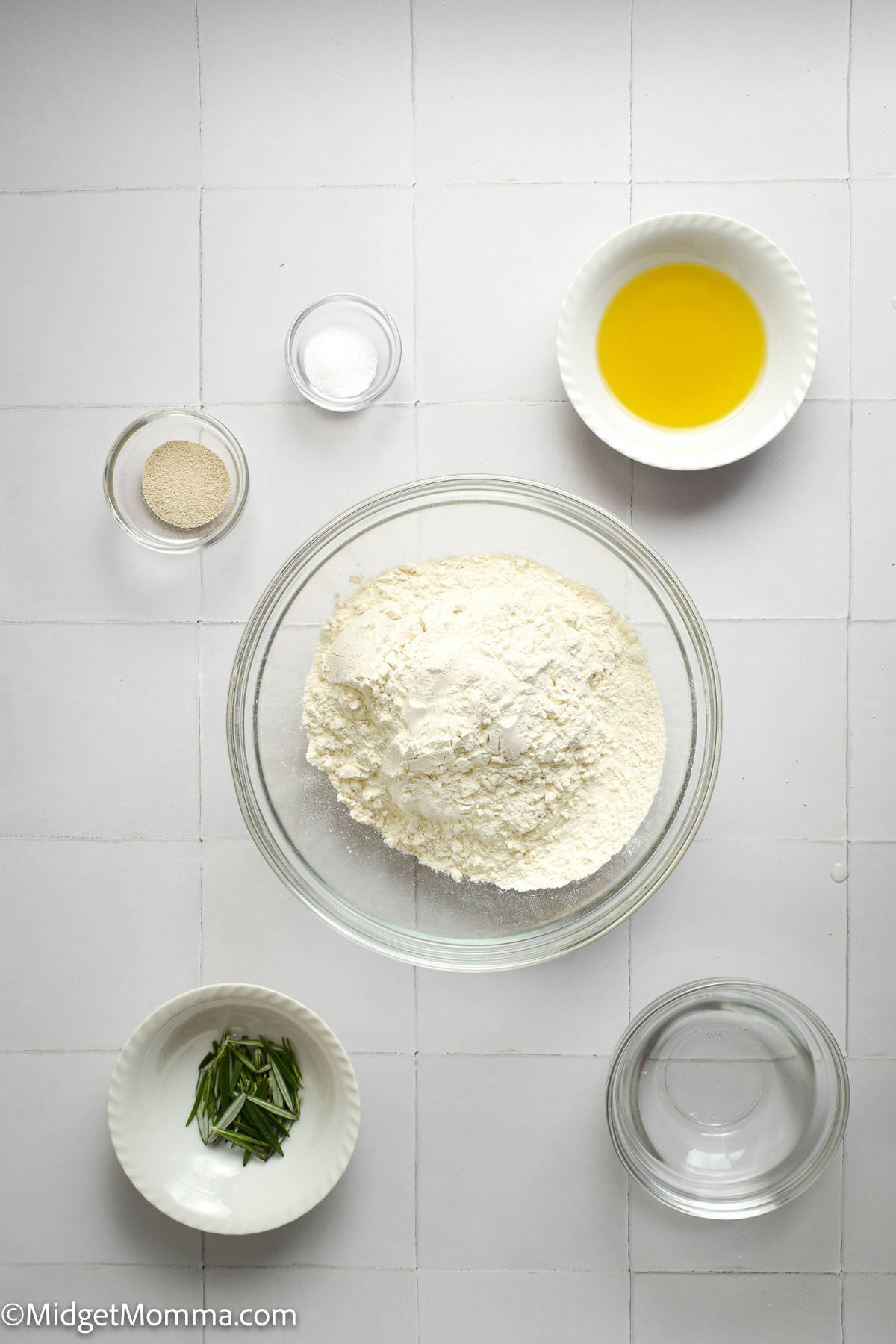
Easy Focaccia Bread Recipe with Rosemary Ingredients
Instant yeast: Yeast is crucial in bread-making as it helps the dough rise by fermenting the sugars present in the flour. Instant yeast, as opposed to active dry yeast, doesn’t require proofing and acts more quickly, aiding in a faster and more efficient rising process.
All-purpose flour: All-purpose flour provides the necessary structure and texture to the focaccia bread. It contains a moderate amount of protein, which helps develop gluten, giving the bread its characteristic chewy texture.
Kosher salt: Salt not only enhances the flavor of the bread but also plays a critical role in controlling the fermentation process. It regulates yeast activity, strengthens the gluten structure, and helps in controlling the rise of the dough, leading to a better-textured final product.
Water: Water is essential for activating the yeast and creating gluten in the flour, forming the structure of the dough. It also helps in hydrating the ingredients and ensuring the right consistency for the dough.
Olive oil (Extra Virgin Olive oil): Olive oil adds flavor and moisture to the bread. It helps create a tender crumb and a crispy crust, contributing to the overall texture and taste of the focaccia. Using high-quality Extra Virgin Olive oil can impart a rich and robust flavor to the bread.
Fresh rosemary: Fresh rosemary lends a fragrant, herbaceous aroma to the focaccia. It adds a distinct flavor profile that complements the olive oil and sea salt, enhancing the overall sensory experience of the bread.
Flaky sea salt: Sprinkling flaky sea salt on top of the focaccia before baking not only enhances the visual appeal but also provides bursts of salty flavor with each bite. It contrasts with the olive oil and herbs, balancing the overall taste of the bread and creating a delightful combination of textures and flavors.
How to Make Easy Focaccia Bread Recipe with Rosemary and Sea Salt
In a large mixing bowl, combine the yeast, salt, and flour and stir to thoroughly mix.
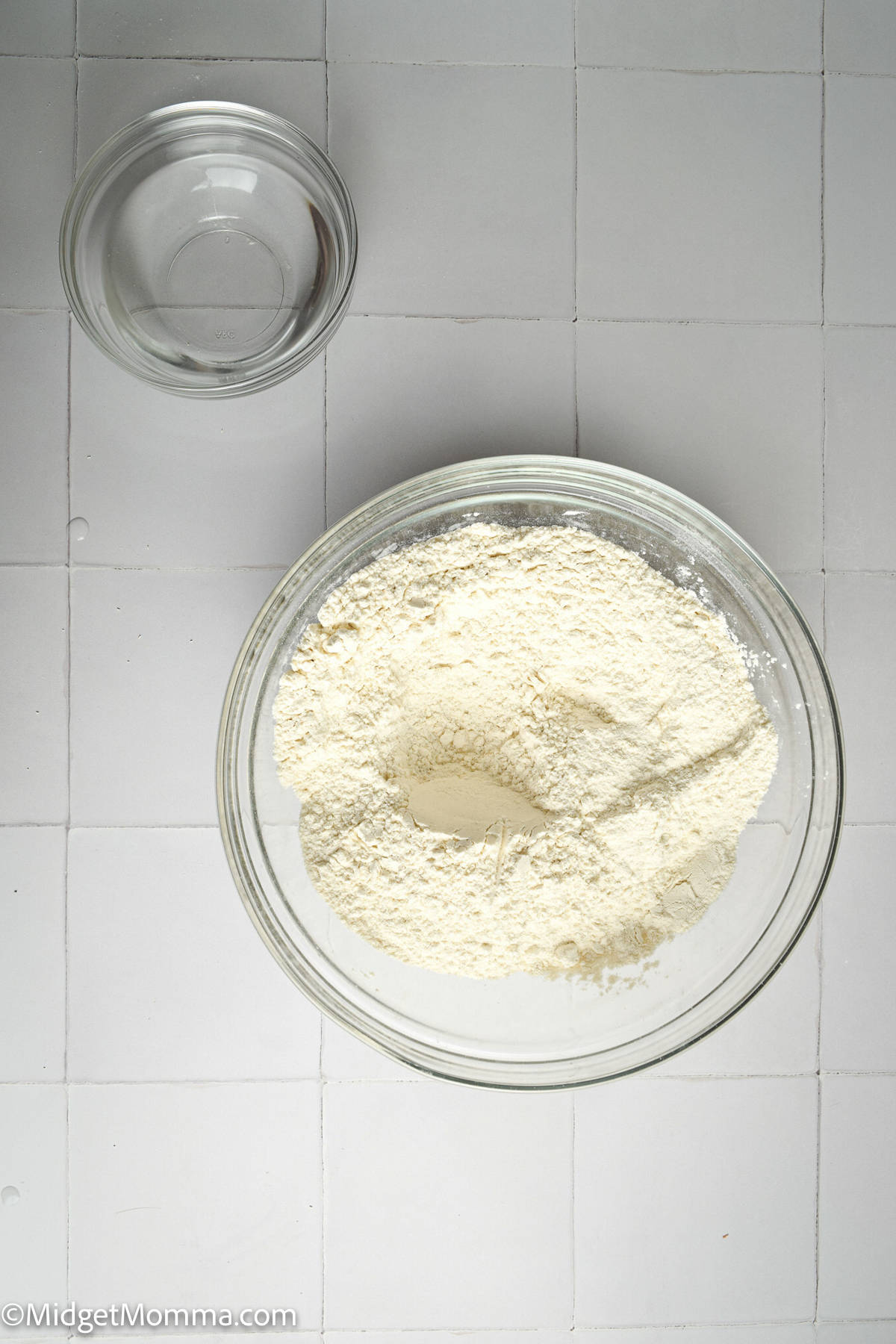
Pour the water into the flour mixture and stir until a slightly uneven dough forms using a rubber spatula. If the dough seems overly wet, add a small amount of flour.
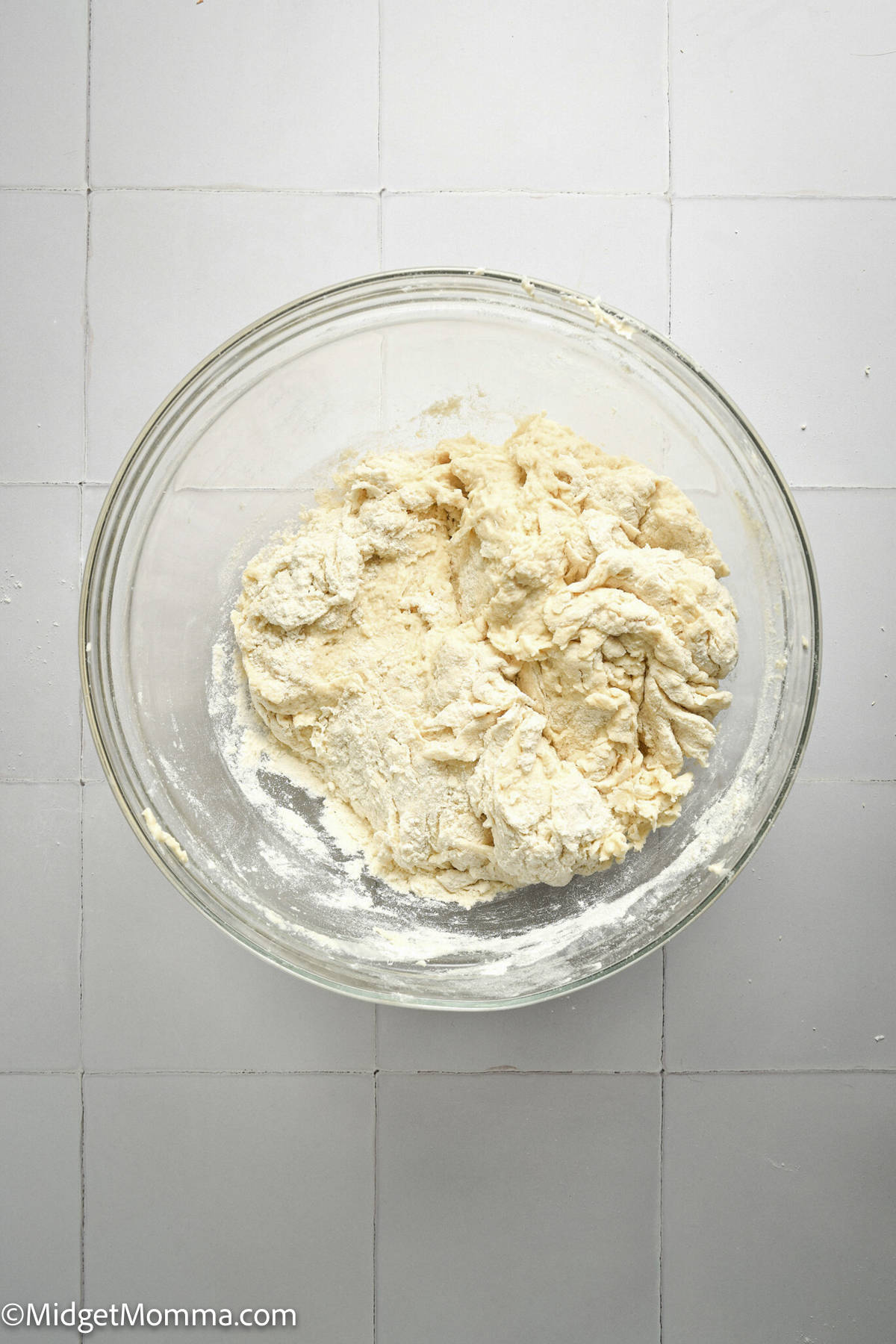
Transfer the dough onto a floured surface. Knead for 5-10 minutes until the texture becomes smooth. You’ll notice the exterior is sleek and soft when gently pressed.
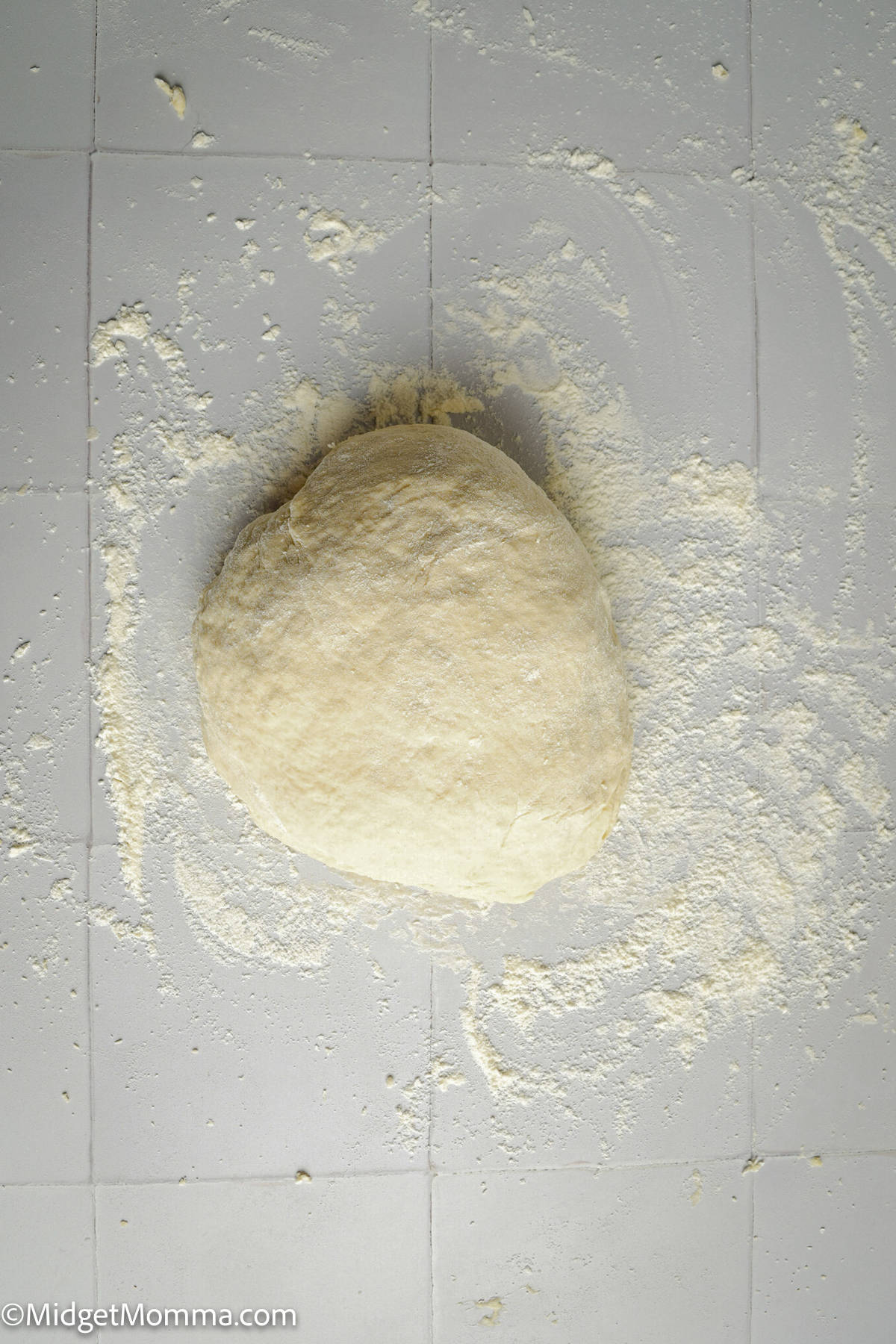
Place the dough in a well-oiled bowl and cover it with a damp kitchen towel. Let it rise undisturbed until it doubles in size, which typically takes 1 to 2 hours.
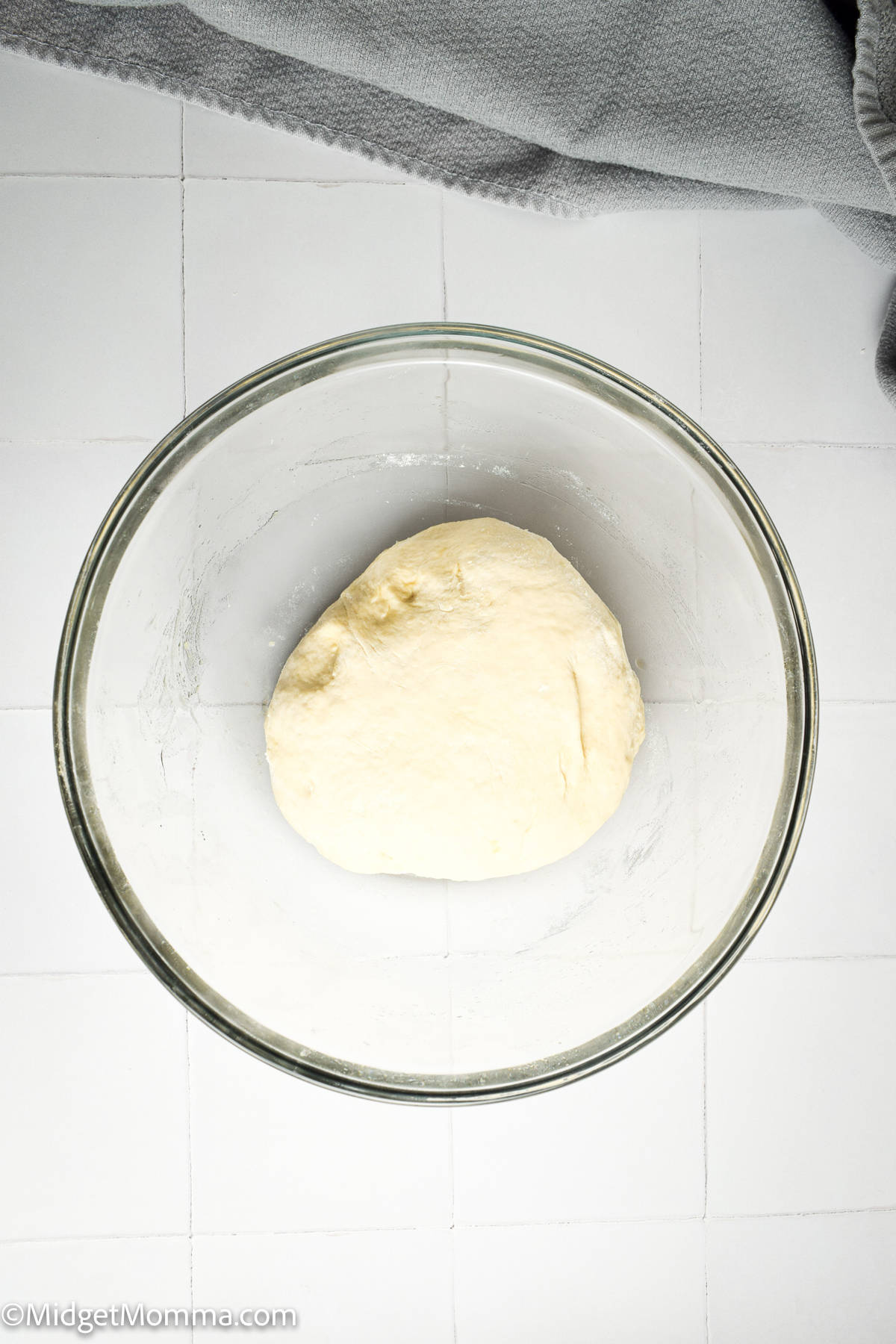
Drizzle the olive oil into a 12-inch cast iron skillet or a 9×13″ pan. Place the dough in the pan and coat it with olive oil. Gently stretch the dough to fit the pan.
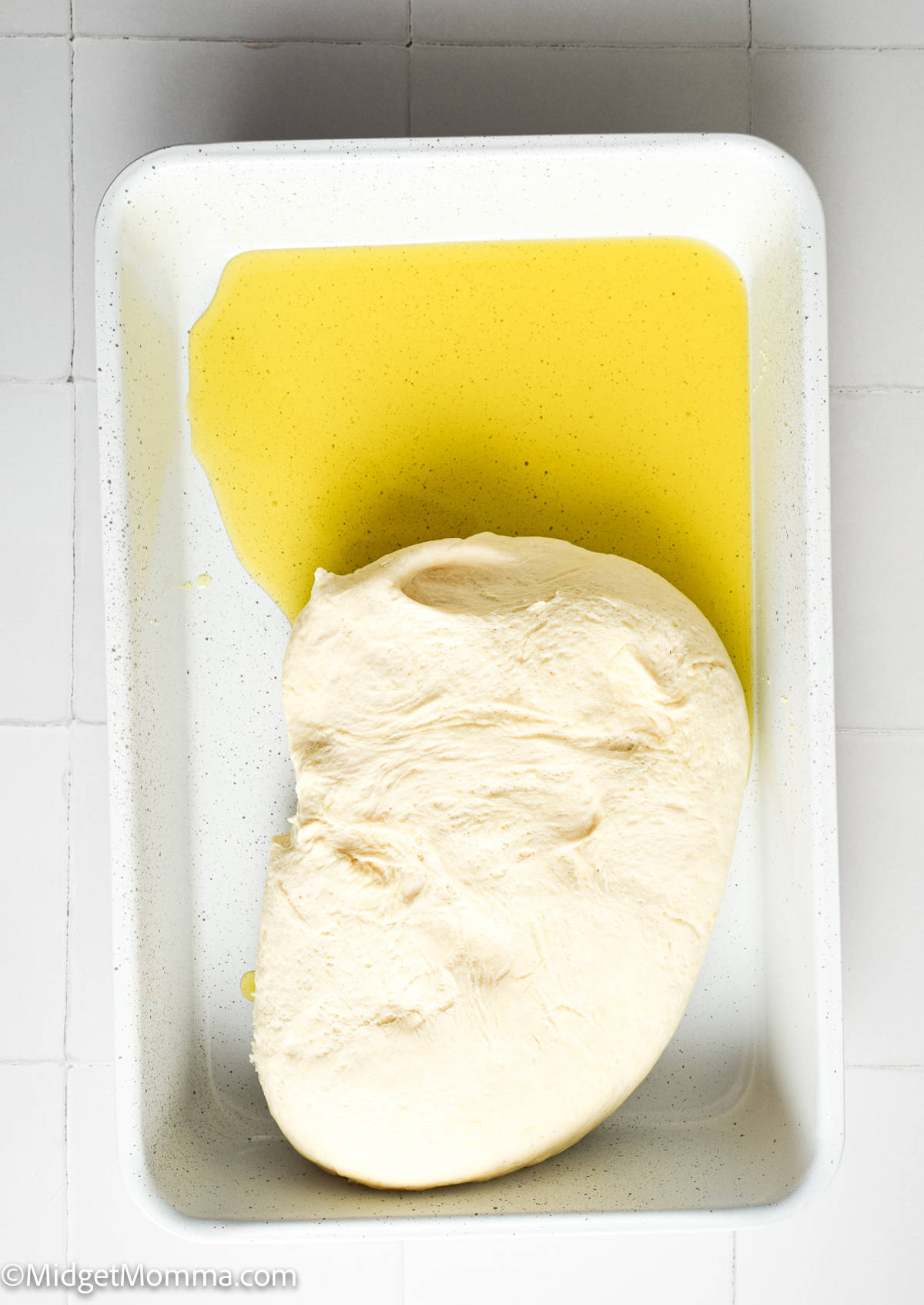
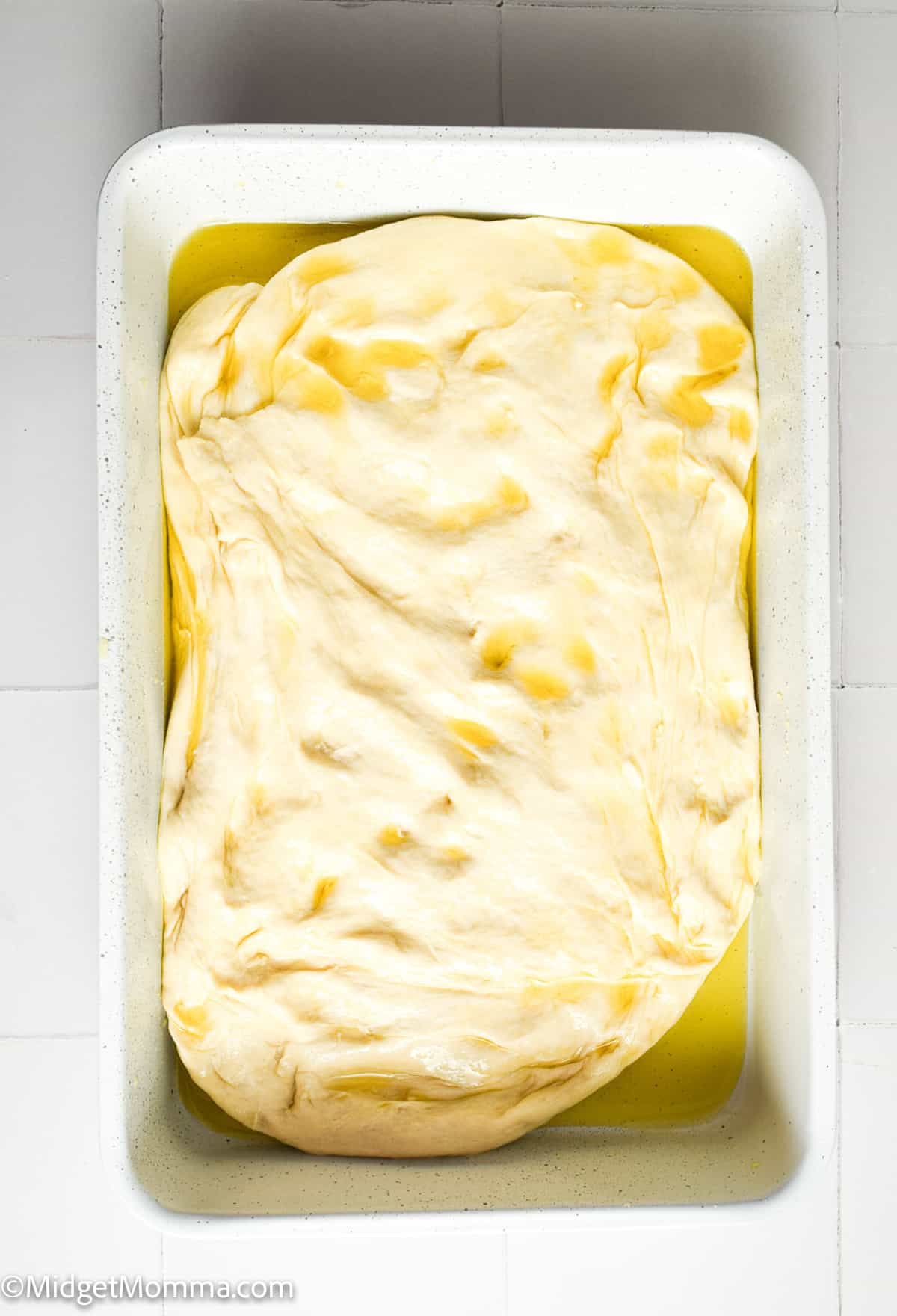
Cover the pan with a damp kitchen towel and let the dough rest until it puffs up and fills the pan, usually, this takes 1 to 2 hours.
Once the dough is ready, lift the edges to release any air bubbles trapped beneath it.
Use your fingers to create small indentations on the surface, characteristic of the classic bumps found in focaccia.
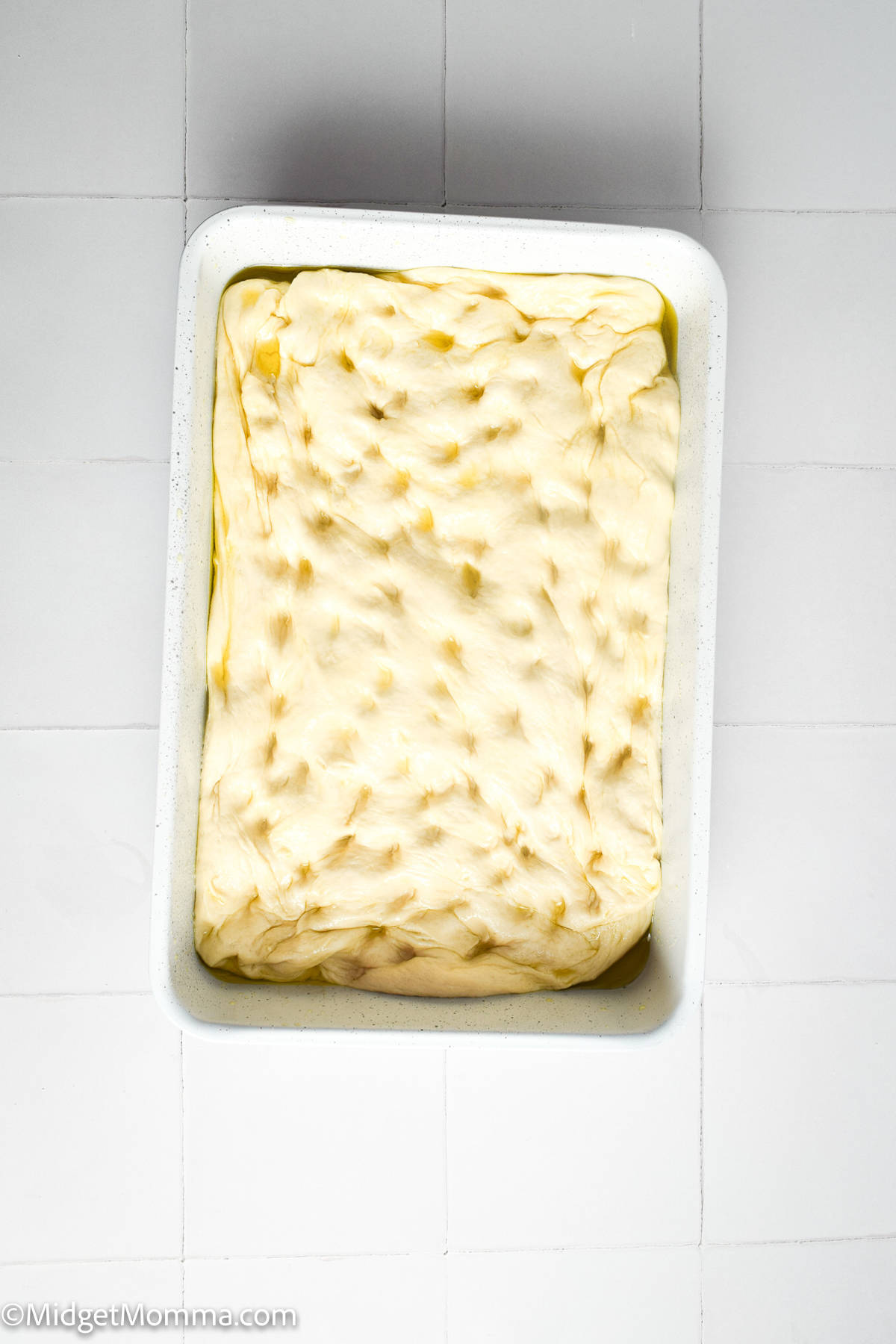
Preheat the oven to 450F.
Sprinkle the dough with sea salt and rosemary.
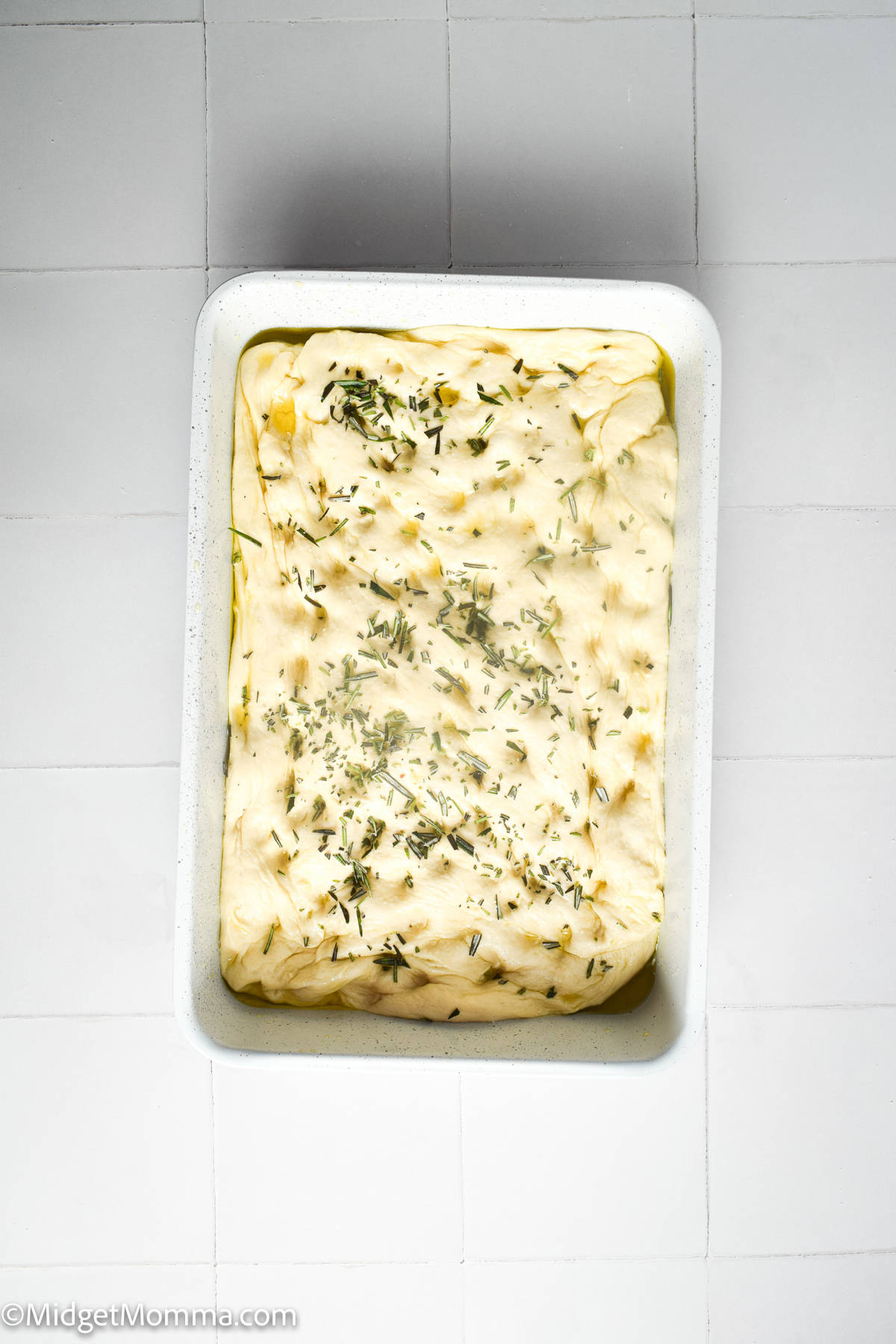
Position the baking pan on the middle rack of the preheated oven.
Bake for 20-25 minutes until the top turns a deep golden brown, achieving a crispy texture.
Remove from the oven, and then place the bread on a wire rack to cool before serving.
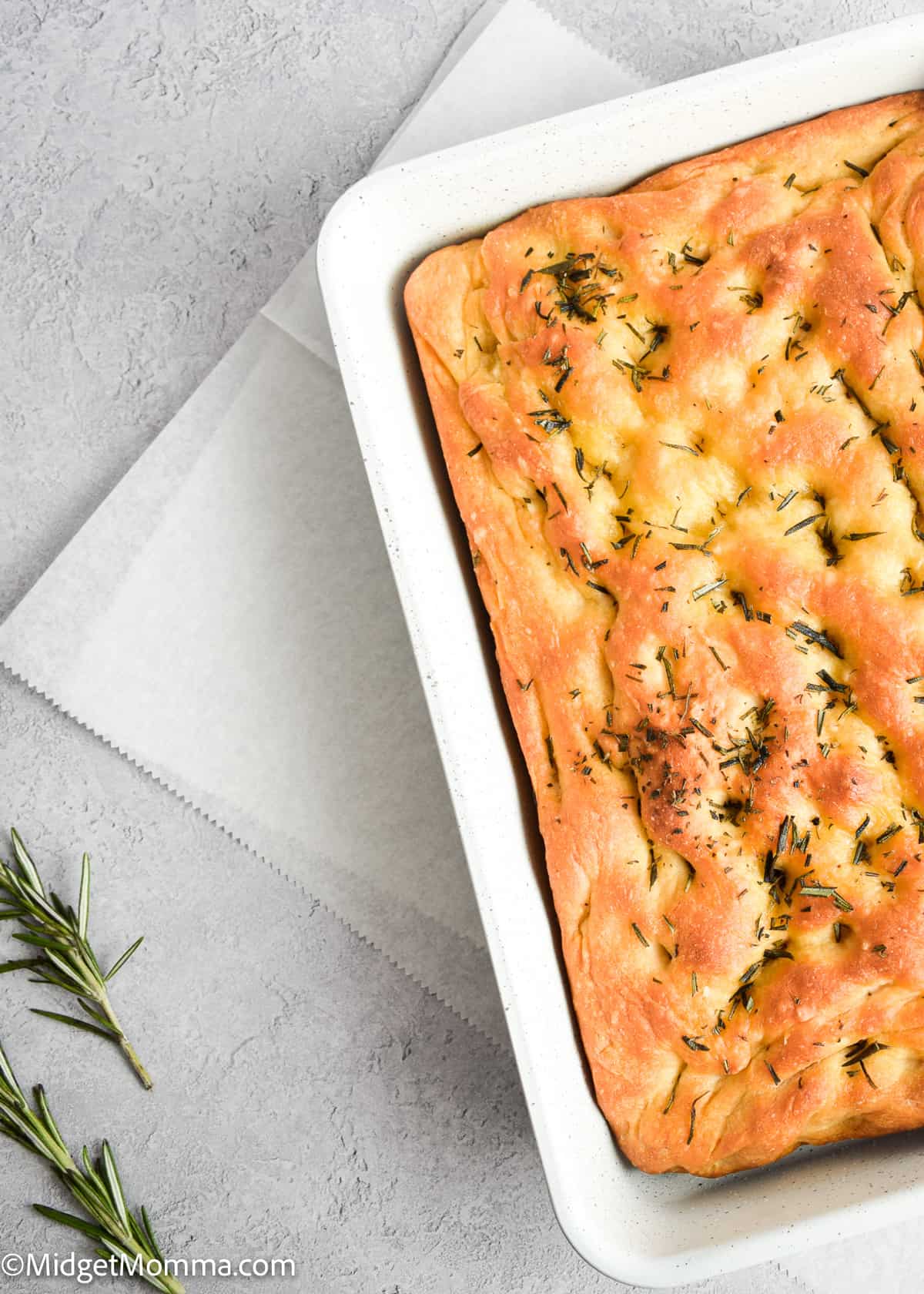
Rosemary Recipes
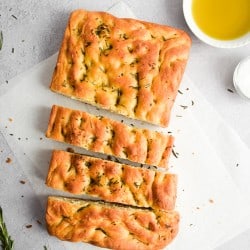
Easy Focaccia bread recipe
Ingredients
- 1 packet instant yeast 2.25 tsp
- 3 1/2 cups all-purpose flour plus more as needed
- 2 teaspoons kosher salt plus more for sprinkling
- 1.5 cups room temperature water
- 3 tablespoons olive oil
- 1 tablespoons fresh rosemary roughly chopped
Instructions
- In a large mixing bowl, combine the yeast, salt, and flour and stir to thoroughly mix.
- Pour the water into the flour mixture and stir until a slightly uneven dough forms using a rubber spatula. If the dough seems overly wet, add a small amount of flour.
- Transfer the dough onto a floured surface. Knead for 5-10 minutes until the texture becomes smooth. You’ll notice the exterior is sleek and soft when gently pressed.
- Place the dough in a well-oiled bowl and cover it with a damp kitchen towel. Let it rise undisturbed until it doubles in size, which typically takes 1 to 2 hours.
- Drizzle the olive oil into a 12-inch cast iron skillet or a 9×13″ pan. Place the dough in the pan and coat it with olive oil. Gently stretch the dough to fit the pan.
- Cover the pan with a damp kitchen towel and let the dough rest until it puffs up and fills the pan, usually, this takes 1 to 2 hours.
- Once the dough is ready, lift the edges to release any air bubbles trapped beneath it.
- Use your fingers to create small indentations on the surface, characteristic of the classic bumps found in focaccia.
- Preheat the oven to 450F.
- Sprinkle the dough with sea salt and rosemary.
- Position the baking pan on the middle rack of the preheated oven.
- Bake for 20-25 minutes until the top turns a deep golden brown, achieving a crispy texture.
- Remove from the oven, and then place the bread on a wire rack to cool before serving.
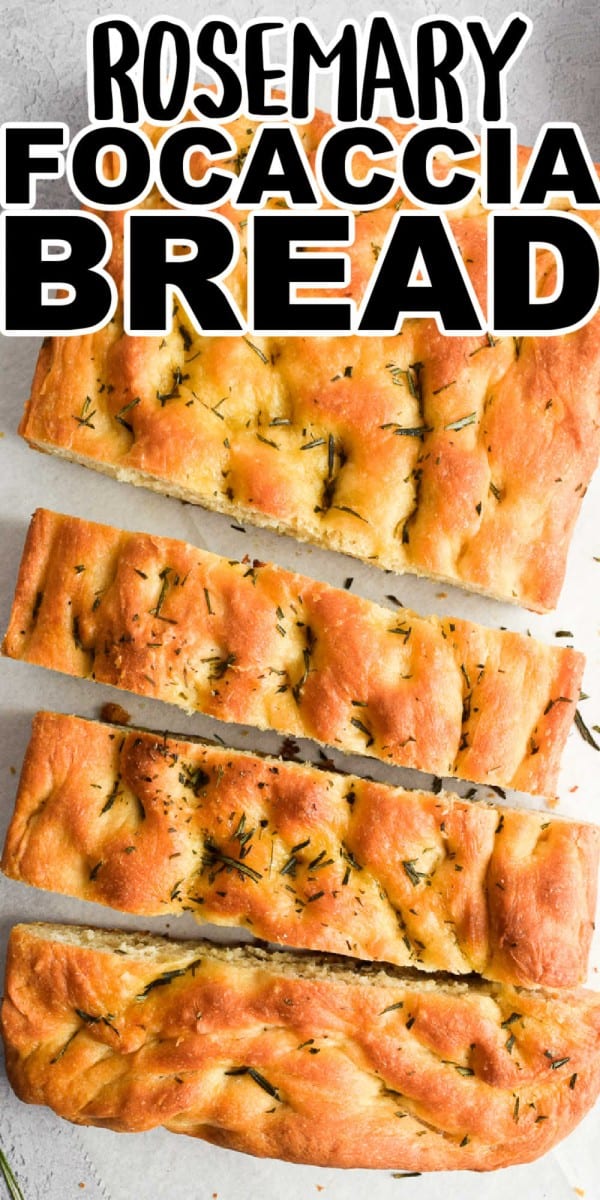
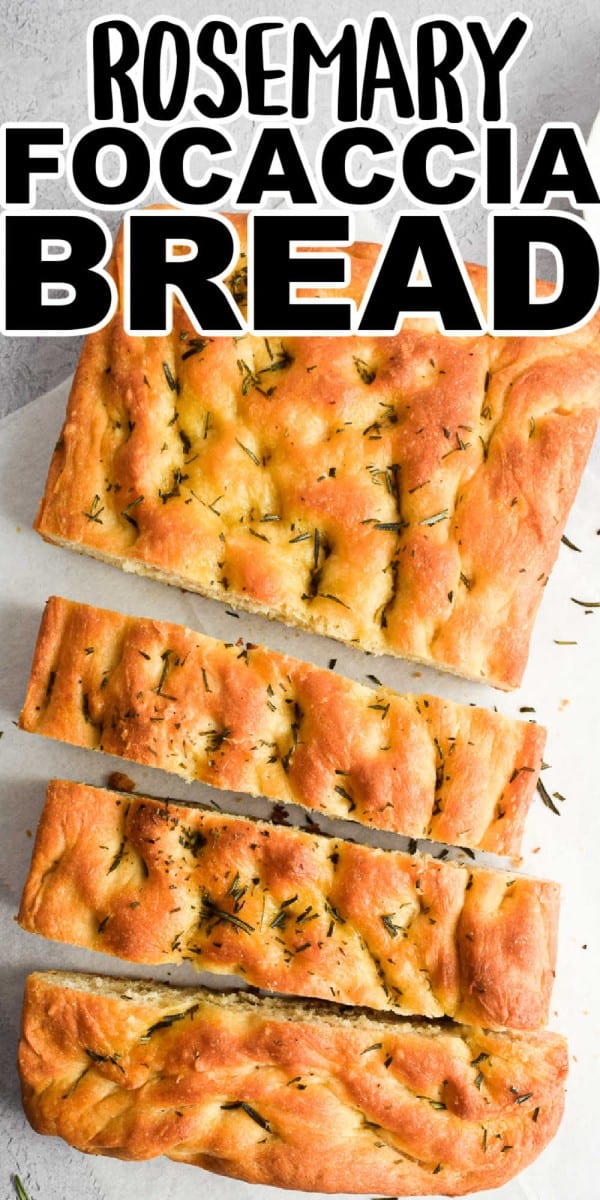
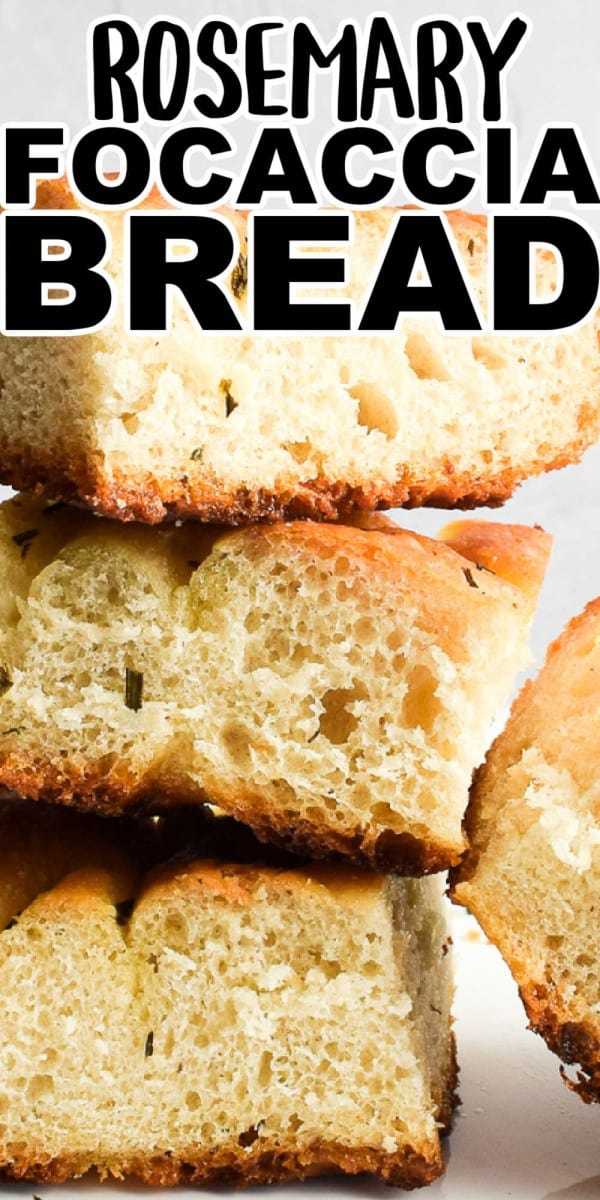
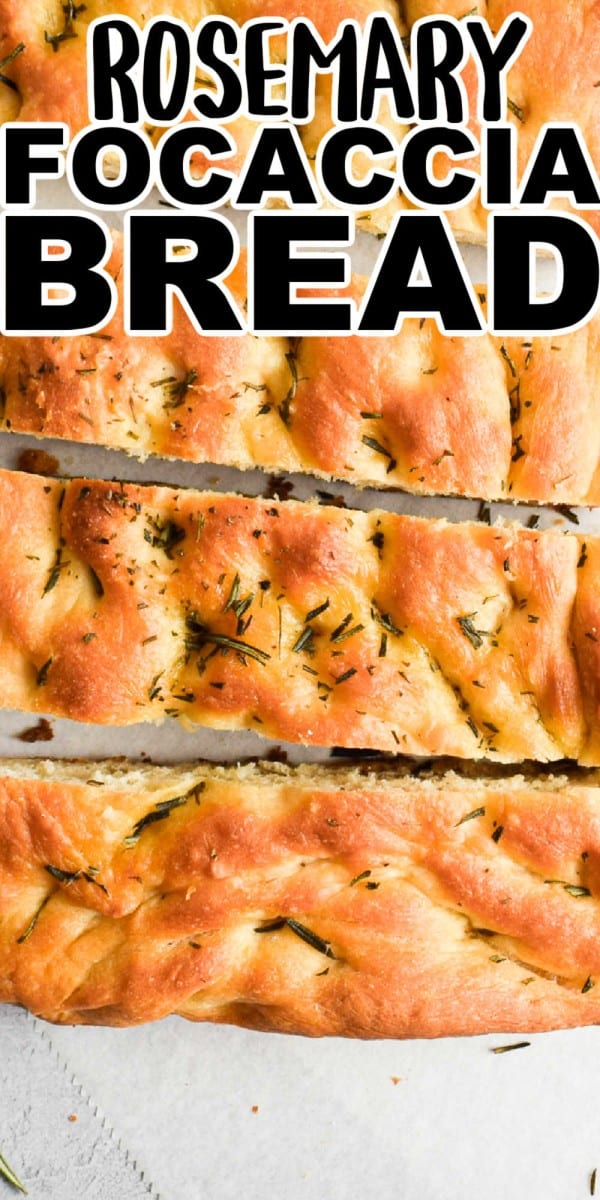
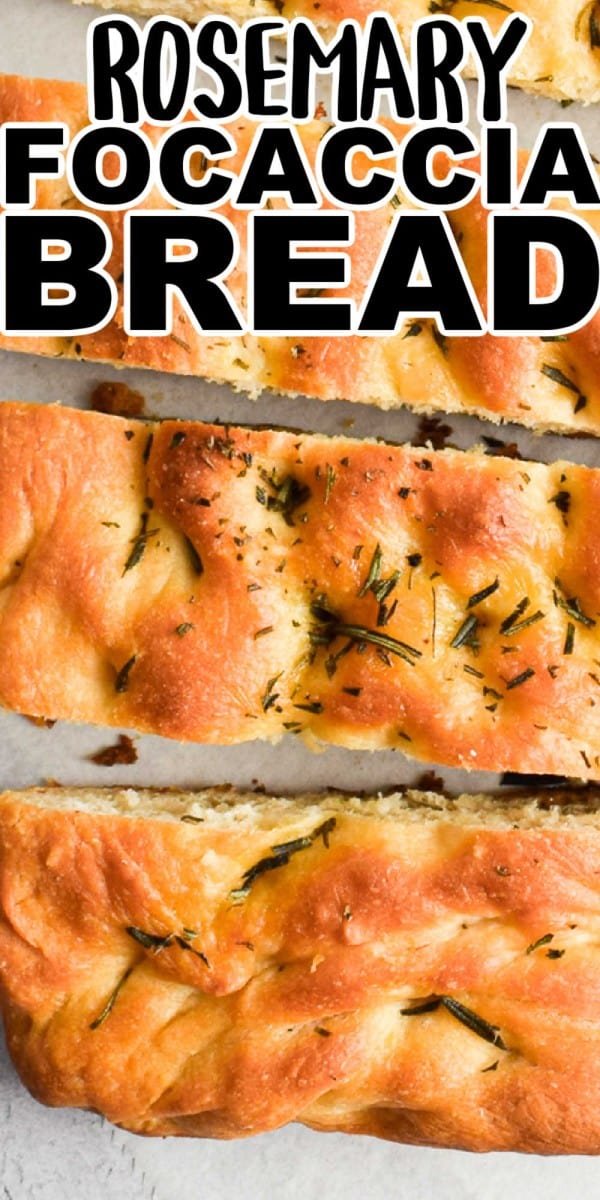
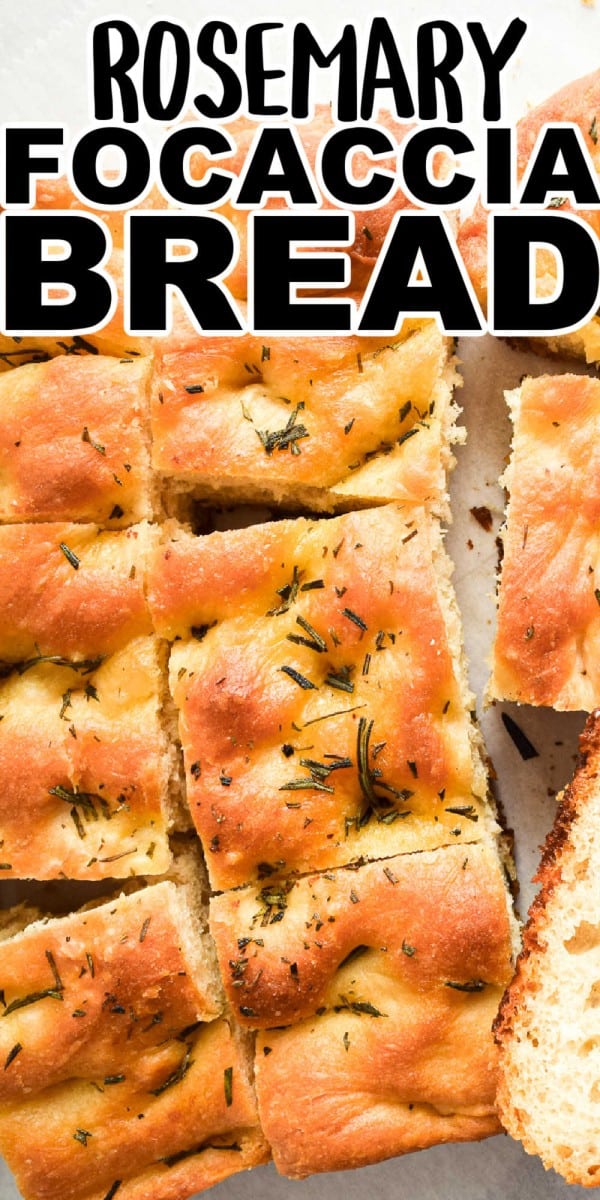
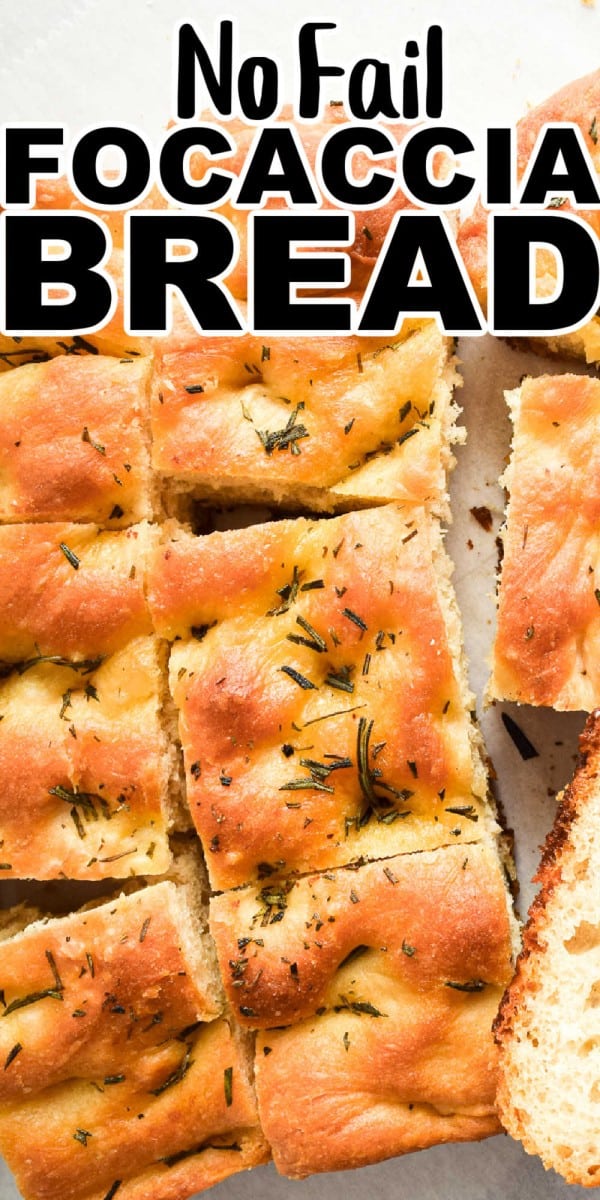
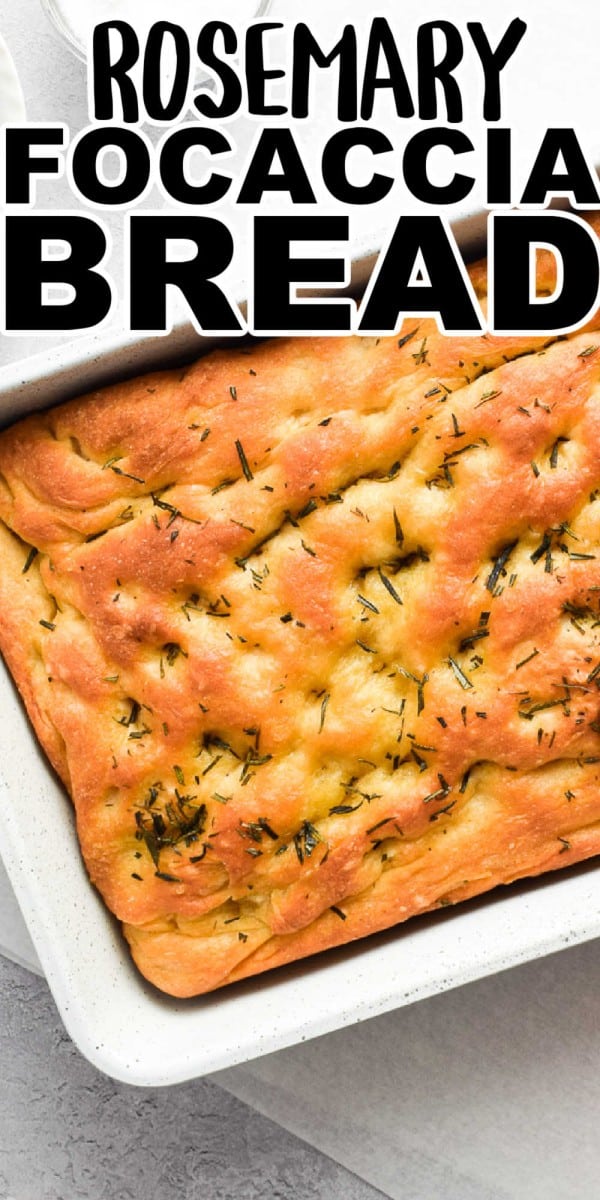
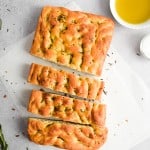







Follow Us For More!
Be sure to share your review in the comments below and follow us on Pinterest, Facebook, Instagram or Tiktok for even more food + family fun!